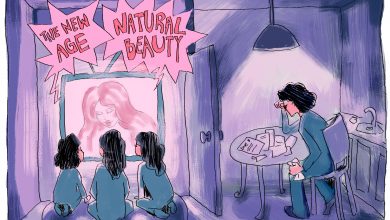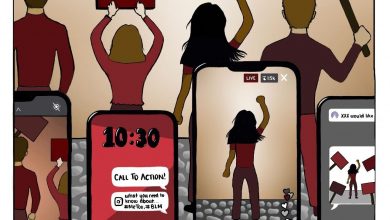Why Gender-Neutral Solutions Don’t Work

Design by Emma Lehman
Gender neutrality is all about avoiding distinction based on one’s sex or gender, usually in order to challenge stereotypes and focus on other factors of one’s identity. However, when men (typically cisgender, white, wealthy) are the ones deciding what is gender-neutral, their choices end up creating and shaping institutions, laws, communities and products that center cis men. Consequently, what is prioritized in a seemingly gender-neutral system is ultimately and inescapably gendered. Neither sex nor gender are binaries, but medical and legal institutions often treat them as such and tend to validate what they view as the default, or gender-neutral, experience. In most cases, this means these institutions are centered around cis men. Women, as well as trans and nonbinary individuals, are ‘othered’ and pushed aside, reinforcing the notion of the sex and gender binary.
Gender neutrality is not inherently a feminist ideology. While feminism is committed to breaking down sex and gender roles, it does not necessarily advocate for gender as a notion to be eradicated altogether. This is especially true when we consider the fact that gender neutrality as it currently exists tends to reinforce sex and gender binaries and stereotypes.
Just as it’s impossible to be colorblind, it’s impossible to be ‘blind’ to sex and gender. Sex and gender differences, while constructed in various ways, have material and physical consequences that are often unavoidable. Gender affects the kinds of work we do, our political and religious beliefs, where we live and how we move in the world. These differences are not insignificant.
Examples of failed gender-neutral solutions range from the seemingly harmless to wide-ranging applications that affect global politics and healthcare. Office temperature is one thing that seems like it couldn’t possibly be gendered. However, research has shown that office temperatures have historically been designed with the resting body temperature of the average cis man in mind. From the size of pockets in clothing to the safety features in many cars, many seemingly insignificant aspects of daily life are small features of a larger system of gender inequality in policy and design.
Gender-neutral solutions don’t just ignore the way women’s lives often differ from men’s, but also the different biologies associated with women, including trans women, as well as intersex and nonbinary individuals. ‘Women’s health’ and life-saving treatment for trans people should be as accessible and important as ‘general health.’ By dividing healthcare into ‘women’s health’ versus ‘general health,’ the medical industry further cements the practice of labeling what is perceived to be ‘male’ as the default, whereas what is associated with women is something more specialized. Women’s healthcare and trans healthcare are crucial aspects of health that are just as important as what we now call ‘general health.’ While the healthcare industry attempts to be gender-neutral, sex and gender remain decisive factors in the type and quality of medical attention that individuals receive.
So much more research has gone into understanding the ‘default’ cis man’s body that doctors of all backgrounds still fail to grasp and diagnose conditions like endometriosis and chronic migraines that affect millions of people in the U.S. This lack of understanding can be chalked up to the fact that it is predominantly women who experience these medical issues. First of all, women are taught not to complain about their pain. When they do, they are often dismissed for being hysterical or unreasonable. Many women are told by their doctors that their pain is “all in their head” when there is no clear diagnosis available.
These issues are compounded by matters of class, race, gender expression, and more. Women of color are up to 4 times more likely to experience complications during pregnancy and childbirth than white women. While this difference is not fully understood, it is likely due to the fact that symptoms in women, and especially women of color, are ignored and mislabeled by doctors.
Trans and nonbinary individuals are also routinely discriminated against in a healthcare system that fails to understand their specific healthcare rights and needs. According to GLAAD, 19 percent of transgender people are without any form of health insurance. Even when these services are available, medical professionals often do not ask about or recognize the preferred gender identity of their patients. This ignorance of gender puts trans and nonbinary people at greater risk for life-threatening diseases like cancer and HIV. This is just another reason why gender- and race-neutral treatment is not really neutral.
Meanwhile, money is poured into research on men’s health issues, such as heart attacks, erectile dysfunction, and more. While several billion dollars are made each year by the breast cancer industry, the majority of breast cancer awareness campaigns objectify women by focusing on the sexualization of breasts rather than the health and wellbeing of women with cancer. Obviously, this exclusion of women and willful ignorance of their pain is not and can not be gender-neutral. Consequently, drugs for many conditions are often centered around cis men’s biology, and research often fails to account for sex differences that may cause a different (and even harmful) reaction in cisgender women. For example, low-dose aspirin is often recommended by doctors as a method of reducing the risk of heart attacks. However, it was just recently discovered that this method is mainly helpful for men, and can actually cause uncontrollable bleeding in many women.
In the legal world, it is crucial to analyze crime and violence through a gendered lens, especially in cases of sexual assault and harassment. Violence is not gender-neutral and neither is society’s understanding of ‘objective truth’ in cases of gender-based crime. Treating the testimony and objectivity of both the accuser and the accused as ‘equivalent’ in such cases is fundamentally unequal. When a man is accused of sexual assault, his version of the truth cannot be given the same weight as the women who brought the accusation forwards.
The reasonable person test is an example of a legal practice used in court that serves to harm women who testify about sexual assault. The reasonable person test judges individuals involved in a potential crime on whether they acted as a reasonable person could. Once again, the appearance of gender neutrality in this test is misleading, as the idea of objectivity and rationality are stereotypically tied to masculinity. Under the reasonable person test, women are likely to be painted as overly emotional and irrational in legal cases.
As feminist scholar Catharine A. MacKinnon writes in her essay titled “Rape: On Coercion and Consent,” rape law “uniformly presumes a single underlying reality, rather than a reality split by the divergent meanings inequality produces.” MacKinnon goes on to explain that because “[men] seldom consider that their experience of the real is anything other than reality, they can only explain the woman’s version as maliciously invented.”
In other words, gender inequality effectively produces gendered versions of reality, therefore creating differences in how a male accused of assault and a woman who has been assaulted feel and discuss their experience of assault. As long as men’s truth and objectivity are valued more highly than women’s truth, this system will further amplify inequality in the law.
It’s important to understand that gender-neutral solutions affect people differently according to class as well as other factors. An understanding of gender is critical in solving the problems that working-class and impoverished individuals face. We must ask who has access to items like birth control and menstrual hygiene products and realize that the scarcity of these resources amongst homeless and incarcerated populations is gendered. On the other hand, many activists and scholars point to the relative ease of accessing condoms as a symbol of gender inequality. The systems in place overwhelmingly prioritize resources that are generally associated with the male or ‘default’ way of being.
Our world is designed for white, wealthy men. Increasingly, this disparity is paraded as gender-neutral, despite that usually being untrue and not even what feminism strives to achieve. Women are not a special interest group, and false gender neutrality only serves to benefit those at the top as long as power is distributed unequally.




